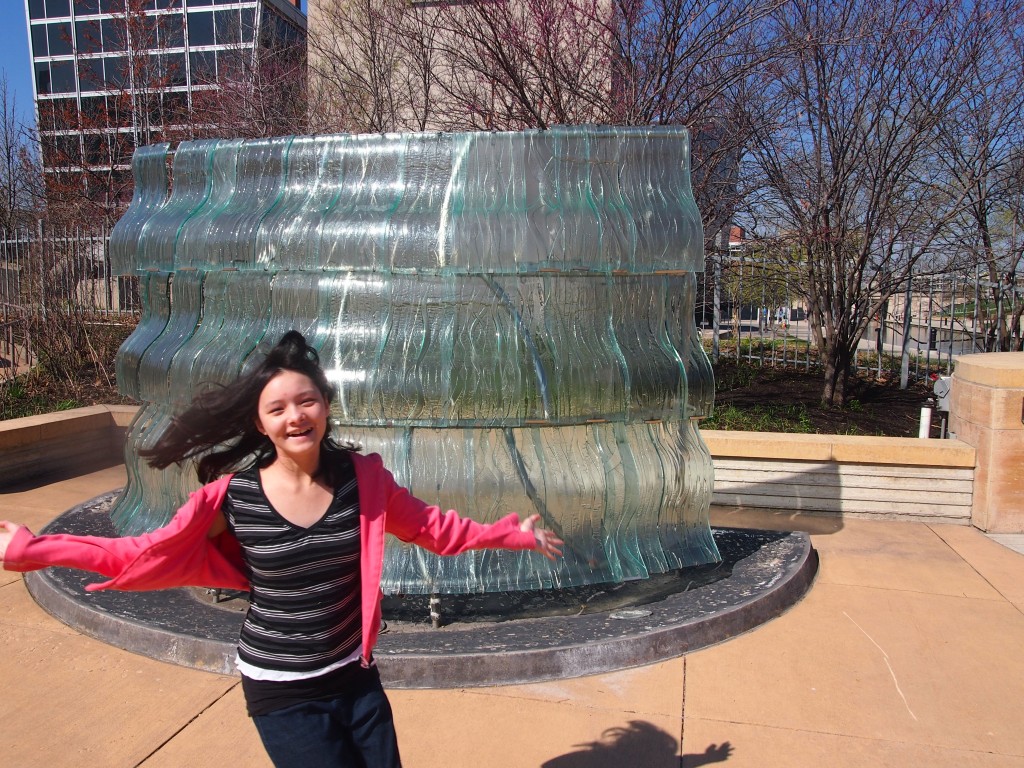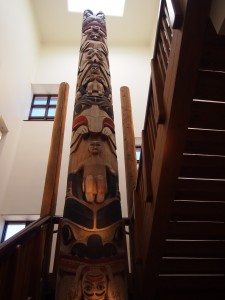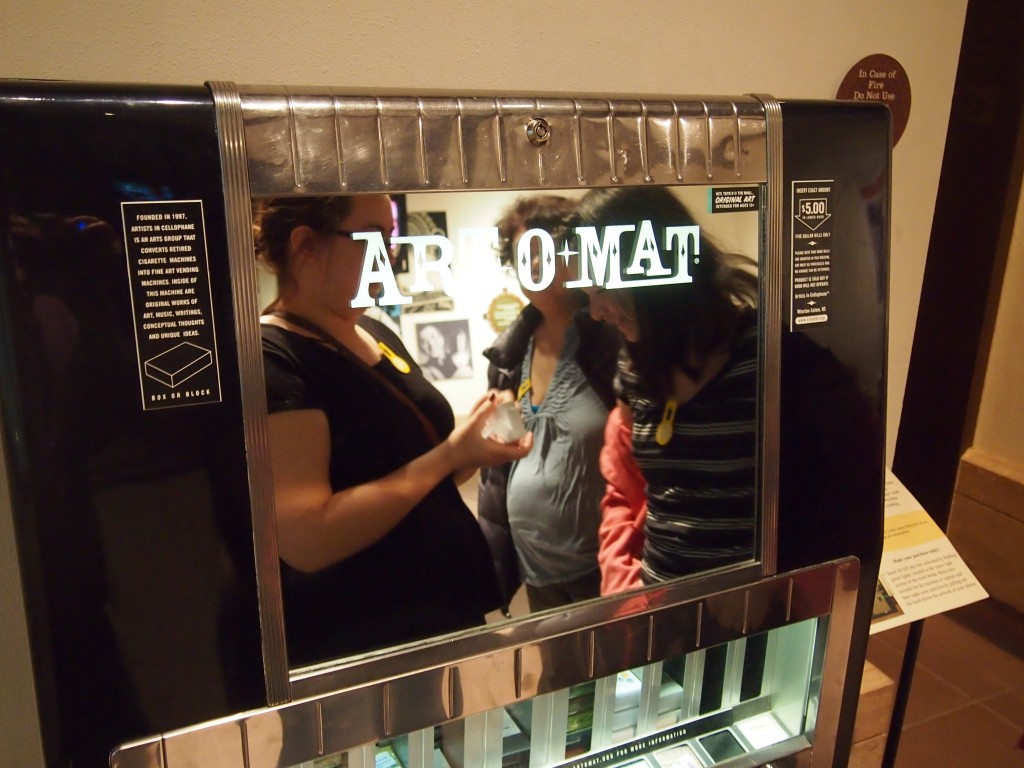The Eiteljorg Museum of American Indians and Western Art is one of a number of attractions at downtown Indianapolis’ White River State Park, just west of the capitol and the CBD. We parked in an underground facility and entered the Eiteljorg through its back entrance, which faces Indy’s canal. The museum’s small sculpture garden is outside that entrance.
When the museum specifies “American Indians and Western Art,” it means Indian art and artifacts of historic interest, but also artwork by contemporary American Indians, as well as art by non-Indians with a theme of the American West. Its collection along these three lines is substantial, housed in a large building adjacent to the Indiana State Museum, and well worth a look.
 Ann’s in front of an example of contemporary Indian art in the sculpture garden: “Water Whispers” (2005), a steel-and-glass creation of Truman Lowe, a Ho-Chunk born in 1944 and professor emeritus at the University of Wisconsin-Madison Art Department.
Ann’s in front of an example of contemporary Indian art in the sculpture garden: “Water Whispers” (2005), a steel-and-glass creation of Truman Lowe, a Ho-Chunk born in 1944 and professor emeritus at the University of Wisconsin-Madison Art Department.
We entered the back entrance and immediately were face-to-face with a totem pole. Nothing like a totem pole right next to you to get your attention.
 It’s a replica of a 19th-century Haida totem pole, carved by one Lee Wallace in 1996, great-grandson of the carver of the original pole, Dwight Wallace. Apparently the original pole had made its way from British Columbia to Alaska to the 1904 St. Louis World’s Fair to Indianapolis industrialist David M. Parry, who kept it on his land (as the Golden Hill totem pole) until it deteriorated and fell in 1939. The new pole, “The Legend of Wasgo,” is made of red cedar with acrylic paint.
It’s a replica of a 19th-century Haida totem pole, carved by one Lee Wallace in 1996, great-grandson of the carver of the original pole, Dwight Wallace. Apparently the original pole had made its way from British Columbia to Alaska to the 1904 St. Louis World’s Fair to Indianapolis industrialist David M. Parry, who kept it on his land (as the Golden Hill totem pole) until it deteriorated and fell in 1939. The new pole, “The Legend of Wasgo,” is made of red cedar with acrylic paint.
The Eiteljorg’s Native American collection, according to the museum, “began with the personal holdings of founder Harrison Eiteljorg and the Museum of Indian Heritage formerly located in Eagle Creek Park. Ranging from traditional objects of material culture such as weaponry, clothing, and basketry, to contemporary Hopi Katsina carvings, jewelry, and Inuit sculpture, the collection includes works of historical and aesthetic significance as well as articles produced for everyday use.”
As for the contemporary Indian art, “the collection consists of copious materials from photographs, beadwork, works on paper and canvas, to beaver fur and hides, traditional paintings and large installation pieces incorporating several mediums. While there is recognizable imagery in a lot of the work, it also represents works that are non-representational such as the work of Harry Fonseca (Maidu/Niseman, Portuguese, Hawaiian) who’s painting is inspired by Navajo blankets or James Lavadour’s (Walla Walla) multifaceted landscapes influenced by hiking through the mountains.”
Two large galleries are devoted to Western-themed art. I’d only vaguely been aware of the Taos School, but I got a lesson about it at Eiteljorg. “The collection is especially strong in art by members of the Taos Society of Artists from the late 1890s to the late 1920s,” the museum notes. “The museum collection also includes an expressive collection of works by early modernist artists who found the West to be inspiring. Among highlights in this broad area are works by Georgia O’Keeffe, Robert Henri, Marsden Hartley, Randall Davey, and many more.”
On exhibit at the Eiteljorg until early August is a fine exhibit of 75 Ansel Adams prints, all apparently selected by the photographer himself at some point as his greatest hits (it could have been as recently as 30-odd years ago; I hadn’t realized, or forgotten, that Adams lived until 1984). A good many images were familiar — great hits, all right — but not all of them, including a handful of portraits of people. Not something he’s known for, but he did them sometimes. One of the portraits was of an elderly woman on a screened-in porch somewhere out West, and she reminded me of my grandmother.
As we were headed for the exit – and the gift shop before that – we chanced across an Art*o*Mat, a repurposed cigarette machine that now sells small pieces of art. I’d seen one of those before, at the Chicago Cultural Center, but that was some years ago. For $5 we got some handmade earrings.
 I also got a picture of my family reflected in the Art*o*Mat mirror.
I also got a picture of my family reflected in the Art*o*Mat mirror.